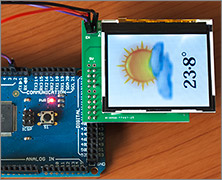Readers with a keen memory will no doubt recall that I said that the N93 would probably be the last of the Nokia QVGA LCDs that I attempt to reverse engineer. However probably is not definitely and one day whilst browsing ebay my finger slipped and next thing I knew I’d got myself an...
Arduino Mega 512K SRAM in shield format
posted by Andy
Some time ago now I presented the design, development board and software driver for an add-on to the Arduino Mega that gave it access to 448Kb of additional SRAM arranged in 8 banks of 56Kb. My design was realised by a compact add-on board that plugged into the relevant block of pins on the...
Reverse engineering the Nokia N93 QVGA LCD
posted by Andy
Welcome to what will probably be the last in the series of articles in which I reverse engineer one of the Nokia QVGA cellphone displays from the pre-smartphone era. I think that by now I’ve covered every possible aspect of these incredibly cost effective little displays and hopefully...
Reverse engineering the Nokia N95 8Gb QVGA LCD
posted by Andy
In this, the latest instalment of my Nokia QVGA TFT reverse engineering series, I will take on the 2.8 inch 24-bit TFT that is designed to work with the Nokia N95 8Gb mobile phone. Read on to see how it worked out. Background In the first of my reverse engineering articles I tackled the Nokia 2730 display. I successfully discovered enough of the command set to write a driver for the Arduino and the STM32. Flush with that success I moved on to tackle the Nokia 6300 and the Nokia N82. I was lucky in that these two shared the same pinout and command set as the 2730 so I could produce a development board with little difficulty. The N95...
Nokia N82 2.4 inch QVGA TFT on the Arduino
posted by Andy
It’s been a few months now since I released the original two articles that detailed the design, build and optimised software library for the 2.0″ Nokia 6300 QVGA TFT connected to the Arduino Mega XMEM interface. Judging by the responses I’ve had, there’s a lot of you...
Nokia QVGA TFT LCD for the Arduino Mega. Design and build (part 1 of 2)
posted by Andy
In two of my previous articles I showed you how to reverse engineer the Nokia 2730 LCD for connecting to a device with 3.3V I/O’s and then I showed you how to build a 16-channel level converter for connecting devices together that have differing I/O level requirements. This article...
Nokia QVGA TFT LCD for the Arduino Mega. Graphics Library (part 2 of 2)
posted by Andy
In part 1 of this two part series I presented the hardware design and build for the Nokia 6300 TFT that shows how we can connect it directly to the external memory interface of the Arduino Mega and that by doing so we achieve the fastest possible interface between the TFT and the Arduino...
512Kb SRAM expansion for the Arduino Mega (design)
posted by Andy
Often when prototyping with an Arduino you run into the memory limitations inherent in a microcontroller programming environment. The Arduino Mega series goes a long way to solving the program size issues, offering as it does 128Kb and 256Kb formats. But what about the SRAM? Even the mega only...








